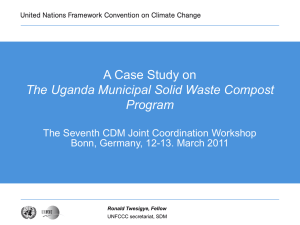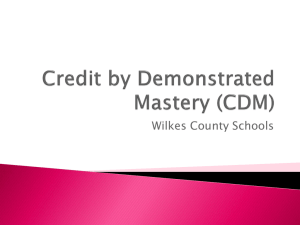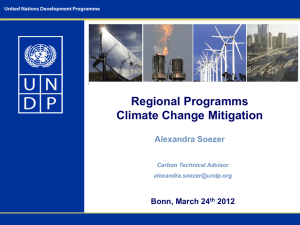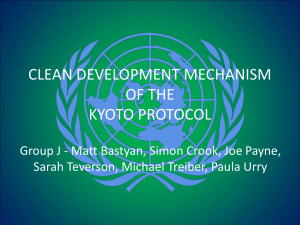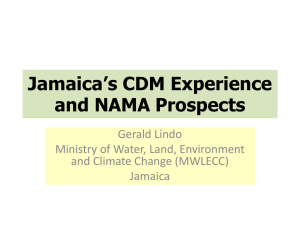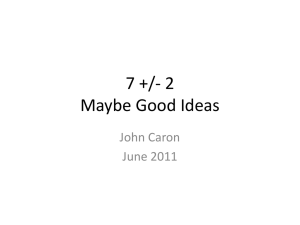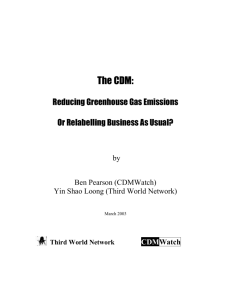Project Idea Note or PIN - Carbon Finance at the World Bank
advertisement
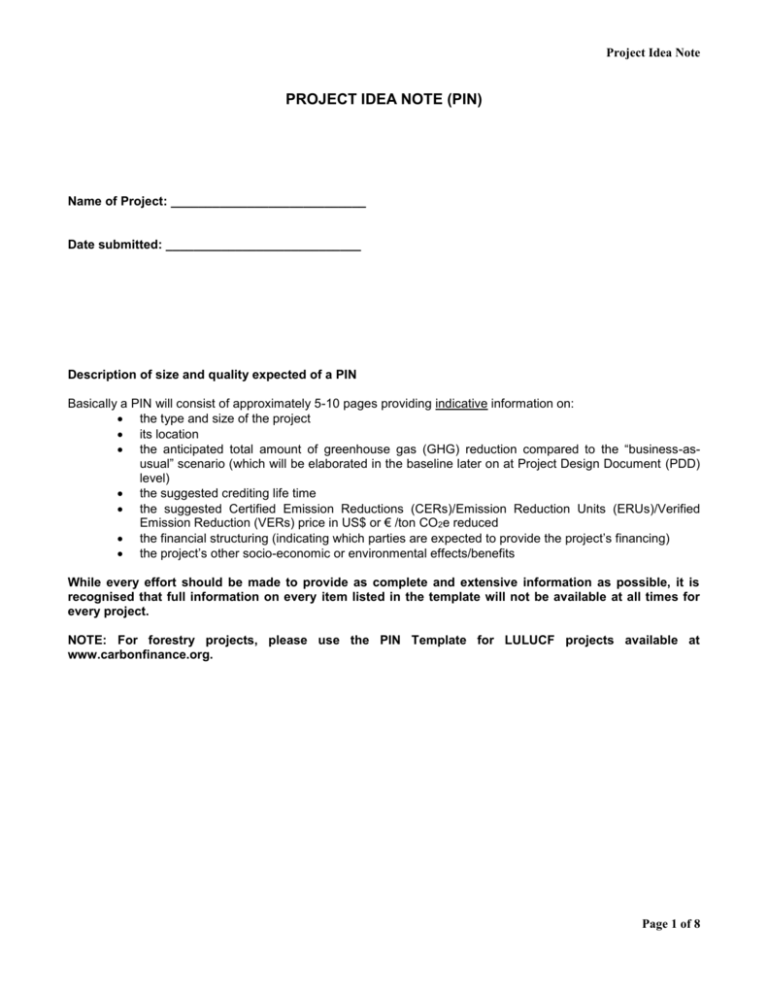
Project Idea Note PROJECT IDEA NOTE (PIN) Name of Project: ____________________________ Date submitted: ____________________________ Description of size and quality expected of a PIN Basically a PIN will consist of approximately 5-10 pages providing indicative information on: the type and size of the project its location the anticipated total amount of greenhouse gas (GHG) reduction compared to the “business-asusual” scenario (which will be elaborated in the baseline later on at Project Design Document (PDD) level) the suggested crediting life time the suggested Certified Emission Reductions (CERs)/Emission Reduction Units (ERUs)/Verified Emission Reduction (VERs) price in US$ or € /ton CO2e reduced the financial structuring (indicating which parties are expected to provide the project’s financing) the project’s other socio-economic or environmental effects/benefits While every effort should be made to provide as complete and extensive information as possible, it is recognised that full information on every item listed in the template will not be available at all times for every project. NOTE: For forestry projects, please use the PIN Template for LULUCF projects available at www.carbonfinance.org. Page 1 of 8 Project Idea Note A. PROJECT DESCRIPTION, TYPE, LOCATION AND SCHEDULE OBJECTIVE OF THE PROJECT Describe in not more than 5 lines PROJECT DESCRIPTION AND PROPOSED ACTIVITIES About ½ page TECHNOLOGY TO BE EMPLOYED1 Describe in not more than 5 lines TYPE OF PROJECT Greenhouse gases targeted CO2/CH4/N2O/HFCs/PFCs/SF6 (mention what is applicable) Type of activities Abatement/CO2 sequestration Field of activities (mention what is applicable) See annex 1 for examples LOCATION OF THE PROJECT Country City Brief description of the location of the project No more than 3-5 lines PROJECT PARTICIPANT Name of the Project Participant Role of the Project Participant a. b. c. d. e. f. g. Organizational category a. b. c. d. e. f. Contact person Address Telephone/Fax E-mail and web address, if any Main activities Describe in not more than 5 lines Summary of the financials Summarize the financials (total assets, revenues, profit, etc.) in not more than 5 lines Summary of the relevant Project Operator Owner of the site or project Owner of the emission reductions Seller of the emission reductions Project advisor/consultant Project investor Other, please specify:________________ Government Government agency Municipality Private company Non Governmental Organization Other, please specify: ________________ 1 Please note that support can only be provided to projects that employ commercially available technology. It would be useful to provide a few examples of where the proposed technology has been employed. Page 2 of 8 Project Idea Note experience of the Project Participant Describe in not more than 5 lines PROJECT PARTICIPANT Name of the Project Participant Role of the Project Participant Organizational category a. b. c. d. e. f. g. a. b. c. d. e. f. Project Operator Owner of the site or project Owner of the emission reductions Seller of the emission reductions Project advisor/consultant Project investor Other, please specify: ________________ Government Government agency Municipality Private company Non Governmental Organization Other, please specify: ________________ Contact person Address Telephone/Fax E-mail and web address, if any Main activities Describe in not more than 5 lines Summary of the financials Summarize the financials (total assets, revenues, profit, etc.) in not more than 5 lines Summary of the relevant experience of the Project Participant Describe in not more than 5 lines Please insert information for additional Project Participants as necessary. EXPECTED SCHEDULE Earliest project start date Year in which the plant/project activity will be operational Estimate of time required before Time required for financial commitments: __ months becoming operational after Time required for legal matters: __ months approval of the PIN Time required for construction: __ months Expected first year of CER/ERU/VERs delivery Project lifetime Number of years For CDM projects: Expected Crediting Period 7 years twice renewable or 10 years fixed For JI projects: Period within which ERUs are to be earned (up to and including 2012) Current status or phase of the Page 3 of 8 Project Idea Note project Identification and pre-selection phase/opportunity study finished/pre-feasibility study finished/feasibility study finished/negotiations phase/contracting phase etc. (mention what is applicable and indicate the documentation) Current status of acceptance of the Host Country Letter of No Objection/Endorsement is available; Letter of No Objection/Endorsement is under discussion or available; Letter of Approval is under discussion or available (mention what is applicable) The position of the Host Country with regard to the Kyoto Protocol Has the Host Country ratified/acceded to the Kyoto Protocol? __________NO / YES, YEAR_______ Has the Host Country established a CDM Designated National Authority / JI Designated Focal Point? __________NO / YES, YEAR_______ B. METHODOLOGY AND ADDITIONALITY ESTIMATE OF GREENHOUSE GASES ABATED/ CO2 SEQUESTERED In metric tons of CO2-equivalent, please attach calculations BASELINE SCENARIO CDM/JI projects must result in GHG emissions being lower than “business-as-usual” in the Host Country. At the PIN stage questions to be answered are at least: Which emissions are being reduced by the proposed CDM/JI project? What would the future look like without the proposed CDM/JI project? About ¼ - ½ page ADDITIONALITY Please explain which additionality arguments apply to the project: Annual (if varies annually, provide schedule): ___ tCO2-equivalent Up to and including 2012: ___ tCO2-equivalent Up to a period of 10 years: ___ tCO2-equivalent Up to a period of 7 years: ___ tCO2-equivalent Page 4 of 8 Project Idea Note (i) there is no regulation or incentive scheme in place covering the project (ii) the project is financially weak or not the least cost option (iii) country risk, new technology for country, other barriers (iv) other SECTOR BACKGROUND Please describe the laws, regulations, policies and strategies of the Host Country that are of central relevance to the proposed project, as well as any other major trends in the relevant sector. Please in particular explain if the project is running under a public incentive scheme (e.g. preferential tariffs, grants, Official Development Assistance) or is required by law. If the project is already in operation, please describe if CDM/JI revenues were considered in project planning. METHODOLOGY Please choose from the following options: For CDM projects: (i) project is covered by an existing Approved CDM Methodology or Approved CDM Small-Scale Methodology (ii) project needs a new methodology (iii) projects needs modification of existing Approved CDM Methodology For JI projects: (iv) project will use a baseline and monitoring plan in accordance with Appendix B of the JI Guidelines and further JISC guidance (V) project will use Approved CDM or CDM Small-Scale Methodology C. FINANCE Page 5 of 8 Project Idea Note TOTAL CAPITAL COST ESTIMATE (PRE-OPERATIONAL) Development costs ___ US$ million (Feasibility studies, resource studies, etc.) Installed costs ___ US$ million (Property plant, equipment, etc.) Land ___ US$ million Other costs (please specify) ___ US$ million (Legal, consulting, etc.) Total project costs ___ US$ million SOURCES OF FINANCE TO BE SOUGHT OR ALREADY IDENTIFIED Equity Name of the organizations, status of financing agreements and finance (in US$ million) Debt – Long-term Name of the organizations, status of financing agreements and finance (in US$ million) Debt – Short term Name of the organizations, status of financing agreements and finance (in US$ million) Carbon finance advance payments2 sought from the World Bank carbon funds. (US$ million and a brief clarification, not more than 5 lines) SOURCES OF CARBON FINANCE Name of carbon financiers other than any of the World Bank carbon funds that your are contacting (if any) INDICATIVE CER/ERU/VER PRICE PER tCO2e3 Price is subject to negotiation. Please indicate VER or CER preference if known.4 TOTAL EMISSION REDUCTION PURCHASE AGREEMENT (ERPA) VALUE A period until 2012 (end of the ___ US$ / € first commitment period) A period of 10 years ___ US$ / € A period of 7 years ___ US$ / € 2 Advance payment subject to appropriate guarantees may be considered. Please also use this figure as the carbon price in the PIN Financial Analysis Model (cell C94). 4 The World Bank Carbon Finance Unit encourages the seller to make an informed decision based on sufficient understanding of the relative risks and price trade-offs of selling VERs vs. CERs. In VER contracts, buyers assume all carbon-specific risks described above, and payment is made once the ERs are verified by the UNaccredited verifier. In CER/ERU contracts, the seller usually assumes a larger component - if not all – of the carbon risks. In such contracts, payment is typically being made upon delivery of the CER/ERU. For more information about Pricing and Risk, see “Risk and Pricing in CDM/JI Market, and Implications on Bank Pricing Guidelines for Emission Reductions”. 3 Page 6 of 8 Project Idea Note Please provide a financial analysis for the proposed CDM/JI activity, including the forecast financial internal rate of return for the project with and without the Emission Reduction revenues. Provide the financial rate of return at the Emission Reduction price indicated in section “Indicative CER/ERU/VER Price”. DO NOT assume any up-front payment from the Carbon Finance Unit at the World Bank in the financial analysis that includes World Bank carbon revenue stream. Provide a spreadsheet to support these calculations. The PIN Financial Analysis Model available at www.carbonfinance.org is recommended. D. EXPECTED ENVIRONMENTAL AND SOCIAL BENEFITS LOCAL BENEFITS E.g. impacts on local air, water and other pollution. GLOBAL BENEFITS Describe if other global benefits than greenhouse gas emission reductions can be attributed to the project. SOCIO-ECONOMIC ASPECTS What social and economic effects can be attributed to the project and which would not have occurred in a comparable situation without that project? Indicate the communities and the number of people that will benefit from this project. About ¼ page What are the possible direct effects (e.g. employment creation, provision of capital required, foreign exchange effects)? About ¼ page What are the possible other effects (e.g. training/education associated with the introduction of new processes, technologies and products and/or the effects of a project on other industries)? About ¼ page ENVIRONMENTAL STRATEGY/ PRIORITIES OF THE HOST COUNTRY A brief description of the project’s consistency with the environmental strategy and priorities of the Host Country About ¼ page Page 7 of 8 Project Idea Note ANNEX I - Technologies 1. Renewables 1a Biomass 1b. Biogas 1c. Bagasse 1d. Wind 1e. Hydro 1f. Geothermal 1g. Photovoltaic 1h. Solar Thermal 2. Fossil Fuel Switch 3. Energy Efficiency 3a. Cement Efficiency Improvement 3b. Construction material 3c. District heating 3d. Steel Gas Recovery 3e. Other Energy Efficiency 4. Waste Management 4a. Landfill Gas recovery/utilization 4b. Composting 4c. Recycling 4d. Biodigestor 4e. Wastewater Management 5. Coalmine/Coalbed Methane 6. Oil and Gas Sector 6a. Flared Gas Reduction 6b. Reduction of technical losses in distribution system 7. N2O removal 8. HFC23 Destruction 9. SF6 Recovery 10. Transportation 9a. Fuel switch 9b. Modal switch 11. Others Page 8 of 8

